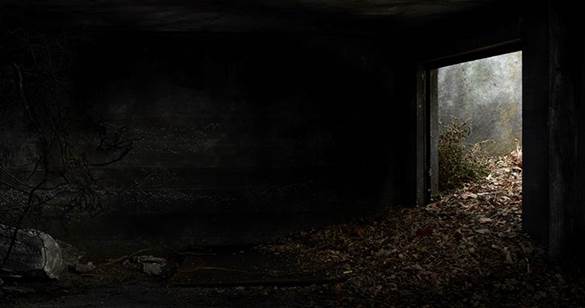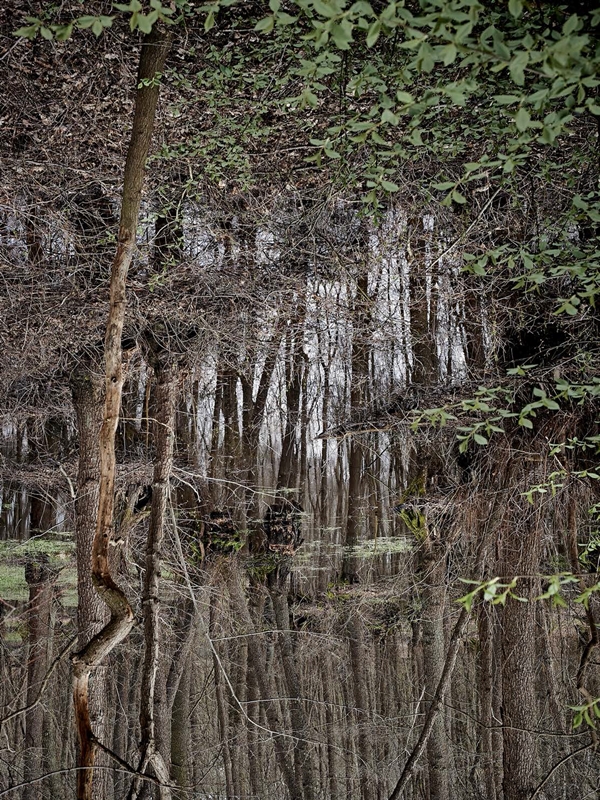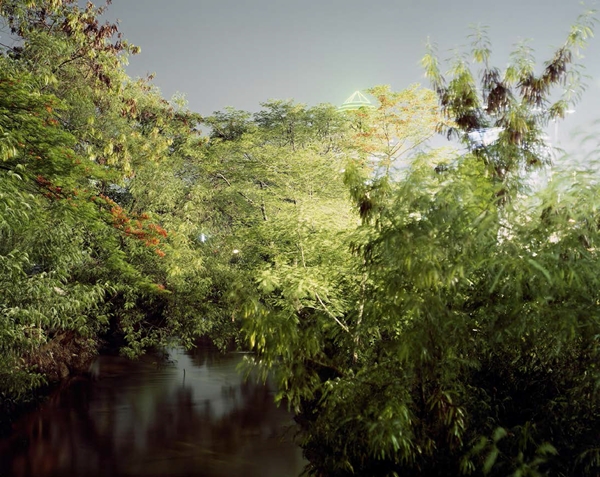"Myth nature, Landscape without horizon"<
Peter Bialobrzeski, Oliver Boberg, Altan Eskin, Julian Faulhaber
/span>

L.A. Galerie Lothar Albrecht
Domstrasse 6 60311 Frankfurt GERMANYT: + 49 – 69 – 288687 e-mail:


December 2, 2017 > January 27th, 2018
 Oliver Boberg: Schacht 7, 2016, Lichtkasten , 35 × 60 cm |
 Julian Faulhaber: Parcel #0036, 2011, 80 × 120 cm |
 Altan Eskin: Shelter #9, 2016, 80 × 60 cm |
 Peter Bialobrzeski: Paradise Now #37, 2006, 60 × 76 cm / 126 × 158 cm |
Landscape without Horizon
Bettina Paust
“Landscape without Horizon” seems to be a contradiction in terms. As the
boundary between the earth and the sky, as the demarcation between below
and above, the horizon appears everywhere in the human environment. Dismissing
scientific fact, human instinct conjures up the illusion of the earth as a
flat plane marked by the horizon and extending into infinity.1 This illusion, in turn,
determines our orientation in the world. As part of the interplay between the vertical,
the way human beings experience themselves due to their upright stance,
and the horizontal, with which we subjectively perceive the surface of the earth
that falls within our range of vision, the line of the horizon plays a decisive role
in getting one’s bearings: above and below is determined, it becomes possible
to estimate distances and the natural limit of human perception is marked.2 …
The development and implementation of the method of depicting space with the aid of central perspective by artists and theoreticians of the Renaissance such as Filippo Brunelleschi, Leon Battista Alberti, Leonardo da Vinci or Albrecht Dürer consummated their involvement in observing and spatially portraying the world around them, including nature as landscape. This method of central perspective is defined by the vanishing point, at which from the observer’s point of view, all parallel lines receding into the distance meet. Moreover, this vanishing point always lies on the line of the horizon. The position of the horizon, on the other hand directly depends on where the viewer is standing. This relationship between viewpoint and horizon characterises the space and the proportional relationships among the objects depicted therein. Intrinsic to the development of central perspective is the assumption that the observer is an individual. Central perspective simultaneously shapes the view of the world and especially of landscape, because, as already implied by Petrarch, this mode of perception posits our physical as well as inner distance in the sense of our not being a part of nature. Consequently, the “unbounding” of the world through the conscious experience and the “delimiting” horizon is closely tied to perspective and the corresponding sociocultural conditions.3
Thus it was a “cultural historical turning point when the horizon was bound to the eye of the observer and no longer referred to an otherworldly view of the world seen ‘from above’, as it had been throughout the Middle Ages”,4 since not only the human point of view defines the position of the horizon, but the horizon also marks the location and subsequently the standing position of the human being. Perspective places him at the very centre of the depicted world. However, the viewer never appears within the picture. Instead, an imaginary or actual screen for projection is pushed between him and the motif, between him and the landscape. Due to the analogy between the process of projection on the eye´s retina in physiological sights and central perspective’s screen for projection on the pictorial surface, a high level of objectivity has been attributed to this method of representation from the very start. This commonality helped the central perspective model of perception and visual representation to be considered the expression of a world view based on visibility and commensurability.
Central perspective photographs, with vanishing point and horizon, projected onto film or today’s sensor chips, seem to demonstrate this assumption. It is no coincidence that the camera’s Iens generally referred to as the objective. Indeed, since the beginning of the twentieth century, art theorists and philosophers have occupied themselves with the essential question concerning photography, its apparently objective view of the world and the possibilities of depicting the world without any conscious artistic intervention.5 Viewers have often used terms such as “true image” or “picture of reality” to describe the medium of photography from its inception to the development of its most disparate forms today. Especially in this age of digital representation, of staged and virtual worlds, it has become even more necessary to question the relationship of photography to the situation in front of the camera, which is captured as a moment in time and space through the eye of the instrument.
Übersetzung Lora Palladion
1 Rosenblum, Robert: Horizone, in “The Perception of the Horizontal, Cologne 2005, p 22 (exh. Cat. Museion – Museum für moderne und zeitgenössische Kunst Bozen)
2 See: Leder, Helmut: Die Horizontale. Wahrnehmungspsychologische Betrachtungen in: “The Perception of the Horizontal, Cologne 2005, p 67 (exh. Cat. Museion – Museum für moderne und zeitgenössische Kunst Bozen)
3 Ipsen, Detlev: Ort und Landschaft, Wiesbaden 2006, p 89
4 Belting Hans, Florenz und Bagdad. Eine westöstliche Geschichte des Blicks, Munich 2008, p 258
5 Gyron, Boris “Die Wahrheit der Fotografie in RAM – Realtität – Anspruch – Medium, ed. Kunstfonds e.V. Bonn 1995, p 149
From „Landschaft ohne Horizont – Nah und Fern in der zeitgenössischen Fotografie“, Verlag für moderne Kunst, 2010, Hrsg. Von der Stiftung Museum Schloss Moyland, © the writer
The development and implementation of the method of depicting space with the aid of central perspective by artists and theoreticians of the Renaissance such as Filippo Brunelleschi, Leon Battista Alberti, Leonardo da Vinci or Albrecht Dürer consummated their involvement in observing and spatially portraying the world around them, including nature as landscape. This method of central perspective is defined by the vanishing point, at which from the observer’s point of view, all parallel lines receding into the distance meet. Moreover, this vanishing point always lies on the line of the horizon. The position of the horizon, on the other hand directly depends on where the viewer is standing. This relationship between viewpoint and horizon characterises the space and the proportional relationships among the objects depicted therein. Intrinsic to the development of central perspective is the assumption that the observer is an individual. Central perspective simultaneously shapes the view of the world and especially of landscape, because, as already implied by Petrarch, this mode of perception posits our physical as well as inner distance in the sense of our not being a part of nature. Consequently, the “unbounding” of the world through the conscious experience and the “delimiting” horizon is closely tied to perspective and the corresponding sociocultural conditions.3
Thus it was a “cultural historical turning point when the horizon was bound to the eye of the observer and no longer referred to an otherworldly view of the world seen ‘from above’, as it had been throughout the Middle Ages”,4 since not only the human point of view defines the position of the horizon, but the horizon also marks the location and subsequently the standing position of the human being. Perspective places him at the very centre of the depicted world. However, the viewer never appears within the picture. Instead, an imaginary or actual screen for projection is pushed between him and the motif, between him and the landscape. Due to the analogy between the process of projection on the eye´s retina in physiological sights and central perspective’s screen for projection on the pictorial surface, a high level of objectivity has been attributed to this method of representation from the very start. This commonality helped the central perspective model of perception and visual representation to be considered the expression of a world view based on visibility and commensurability.
Central perspective photographs, with vanishing point and horizon, projected onto film or today’s sensor chips, seem to demonstrate this assumption. It is no coincidence that the camera’s Iens generally referred to as the objective. Indeed, since the beginning of the twentieth century, art theorists and philosophers have occupied themselves with the essential question concerning photography, its apparently objective view of the world and the possibilities of depicting the world without any conscious artistic intervention.5 Viewers have often used terms such as “true image” or “picture of reality” to describe the medium of photography from its inception to the development of its most disparate forms today. Especially in this age of digital representation, of staged and virtual worlds, it has become even more necessary to question the relationship of photography to the situation in front of the camera, which is captured as a moment in time and space through the eye of the instrument.
Übersetzung Lora Palladion
1 Rosenblum, Robert: Horizone, in “The Perception of the Horizontal, Cologne 2005, p 22 (exh. Cat. Museion – Museum für moderne und zeitgenössische Kunst Bozen)
2 See: Leder, Helmut: Die Horizontale. Wahrnehmungspsychologische Betrachtungen in: “The Perception of the Horizontal, Cologne 2005, p 67 (exh. Cat. Museion – Museum für moderne und zeitgenössische Kunst Bozen)
3 Ipsen, Detlev: Ort und Landschaft, Wiesbaden 2006, p 89
4 Belting Hans, Florenz und Bagdad. Eine westöstliche Geschichte des Blicks, Munich 2008, p 258
5 Gyron, Boris “Die Wahrheit der Fotografie in RAM – Realtität – Anspruch – Medium, ed. Kunstfonds e.V. Bonn 1995, p 149
From „Landschaft ohne Horizont – Nah und Fern in der zeitgenössischen Fotografie“, Verlag für moderne Kunst, 2010, Hrsg. Von der Stiftung Museum Schloss Moyland, © the writer
 Peter Bialobrzeski |
 Oliver Boberg |
 Julian Faulhaber |
Opening :
Saturday, December, 2nd, 2017 from 11am until 6pm








